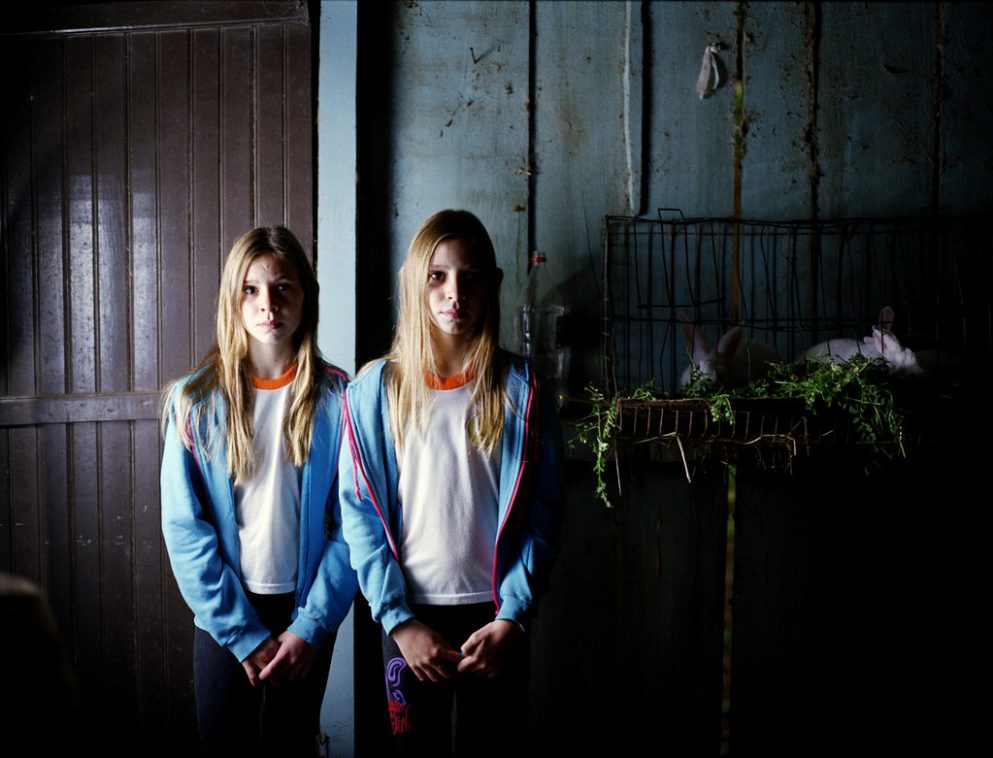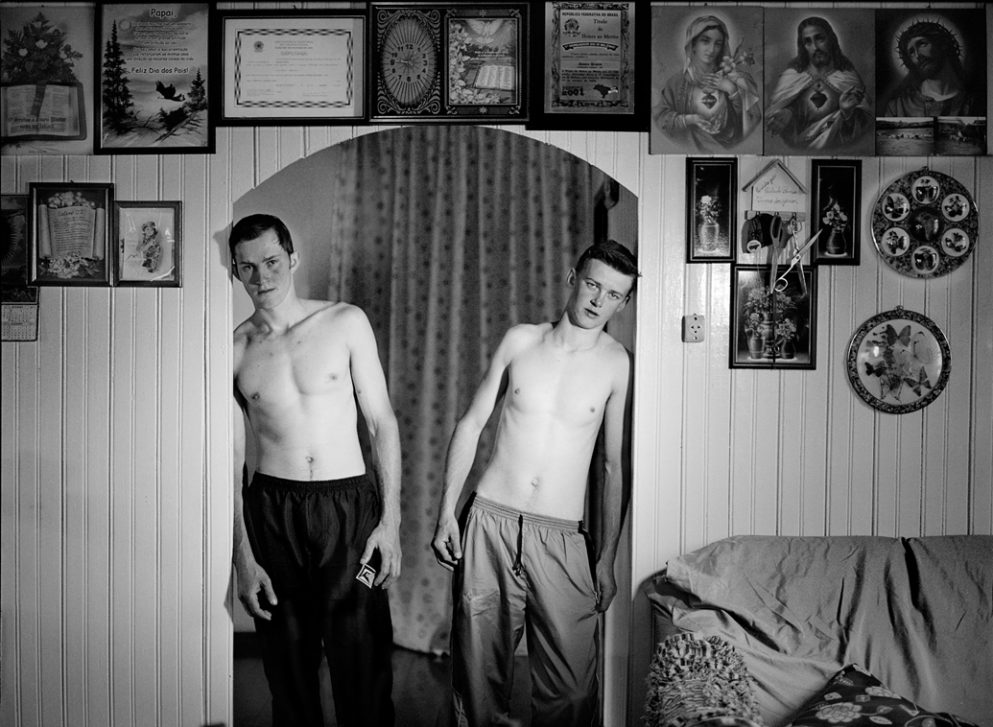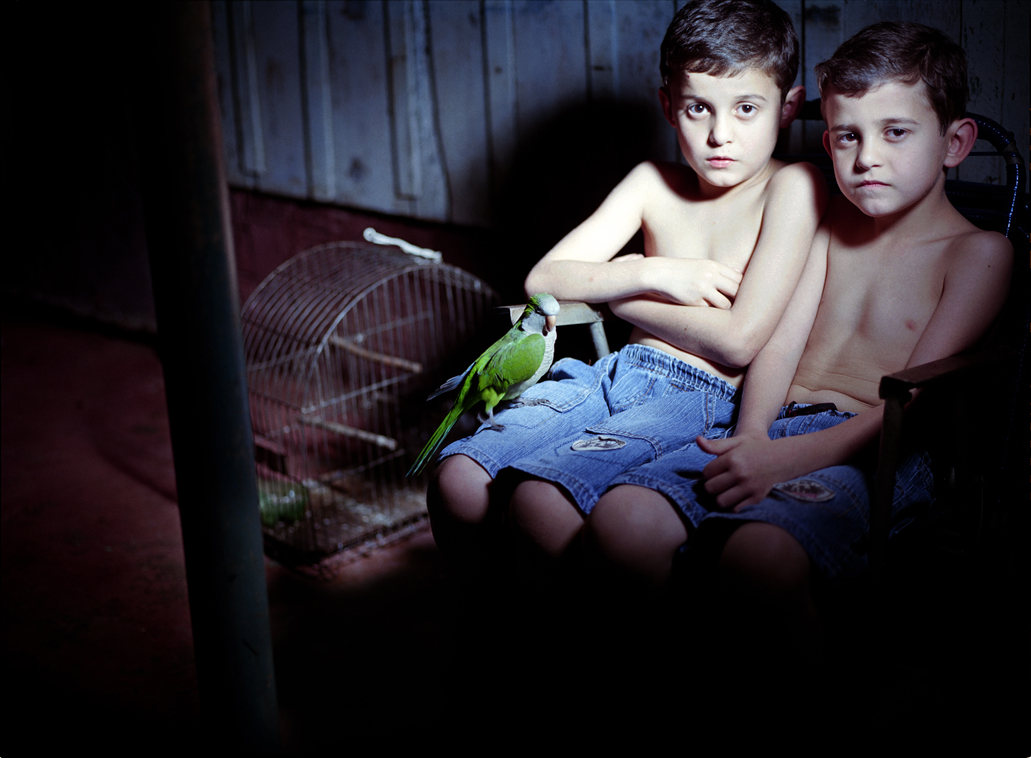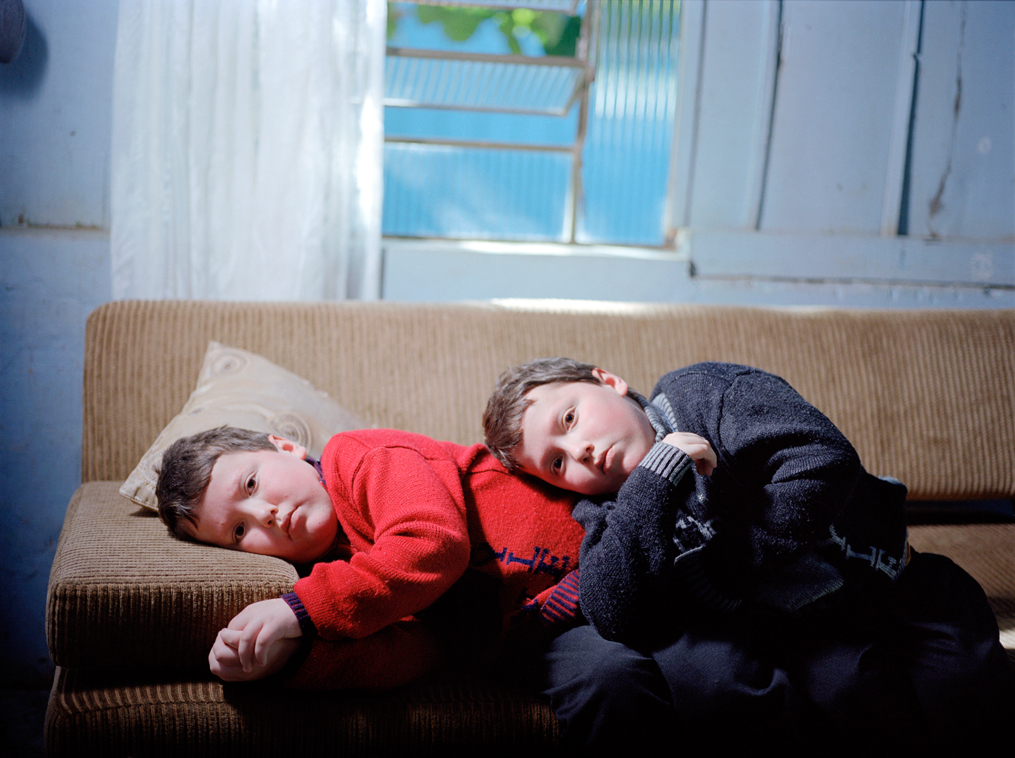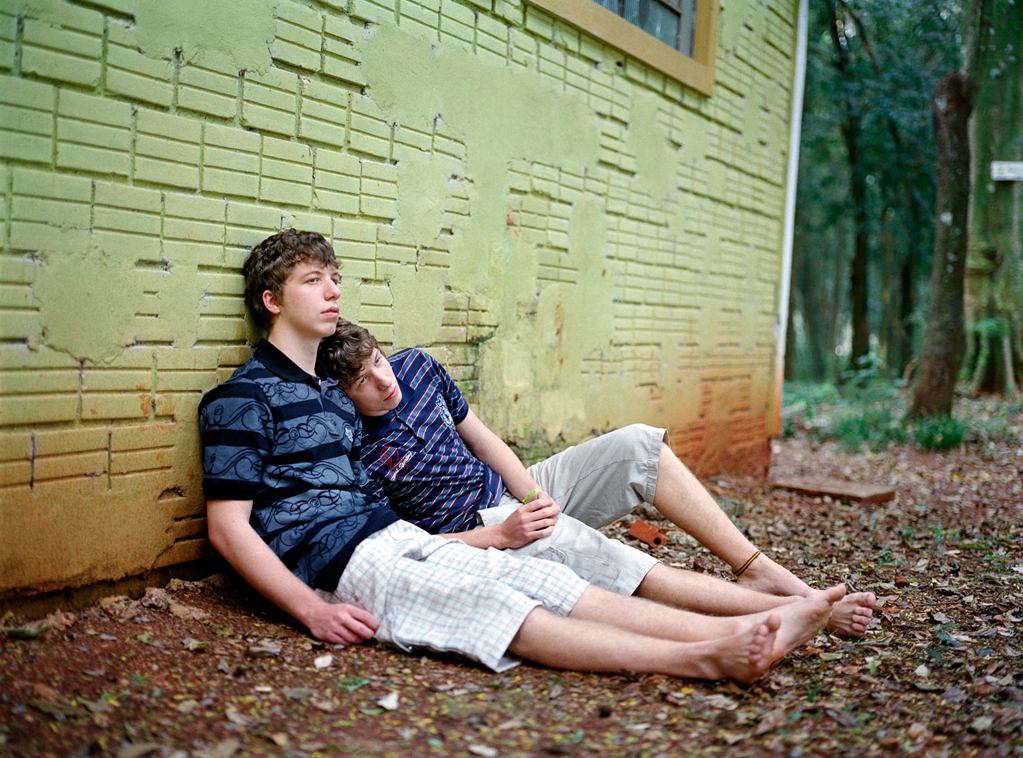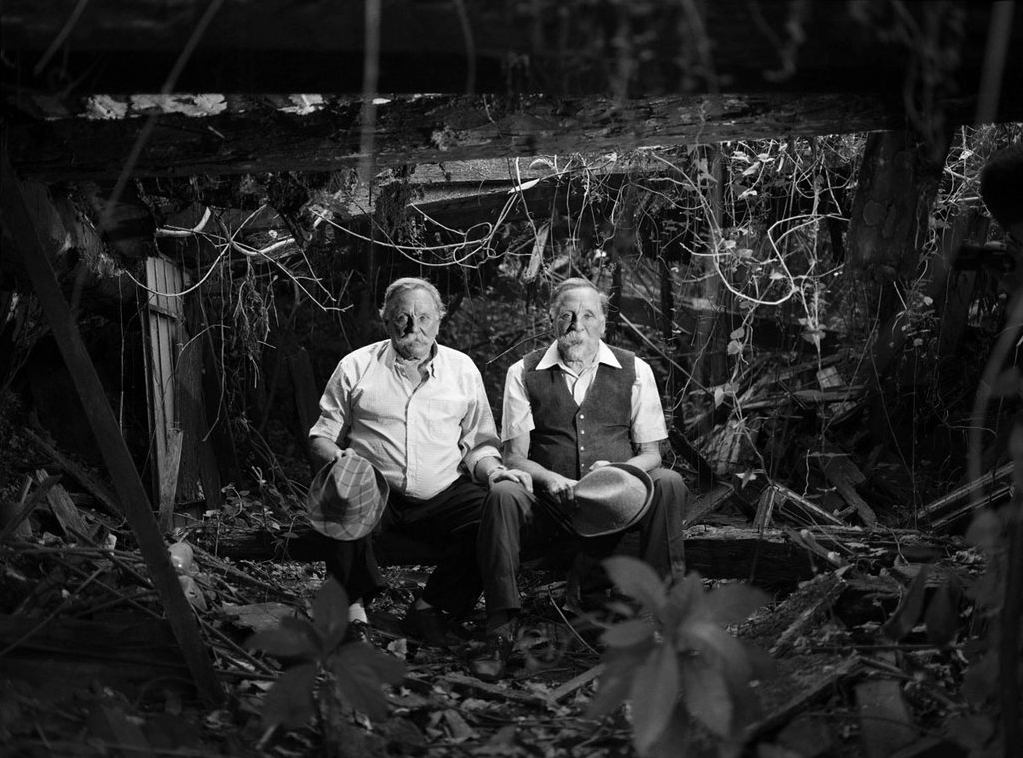Noga Shtainer
„Twins – Duo Morality“
I am looking at the photographs taken by Noga Shtainer. A black-and white photograph. Eyes scrape the vegetation from the paper in order to arrive at what seems to be hidden, what will appear in the future. They look at me as if in the act of discovery. Within the tangle of shrubbery Hansel and Hansel are revealed, sporting bushy mustaches, dressed in bright collared shirts, one of them in a jacket as well, sitting on a low wooden beam, their feet touching the ground. They are holding a hat, one of them resting his hand on the other’s knees. They are seated restfully, awaiting the act of discovery. They level their gaze at me as if pretending to have been caught. A beam of light is focused upon them. Around them, they who seem to have always been there, the tangled shrubbery spreads, enveloping the wood cabin in which they live.
Eyes pass over the photographs, trying to draw out the visual unconscious, trying to identify the photographer’s act of power. If we delve into the picture protractedly, we may be able to acknowledge how tangential the oppositions are to each other. The photographed subjects have names, but something about their appearance eliminates their name. They are not eager to be photographed.
Noga Shtainer offers material for our observation that is not the usual material of portraiture. Sometimes the feeling arises that the figures are digging into the photograph, trying to be swallowed within it, as if something about the refraction of the light is causing them to be smeared over the negative. The observation is seemingly from a vantage point, but one where the viewer first of all needs protection. The figures appear imprisoned inside the frame, as if coerced into being there.
A color photograph: Tamara and Samara are standing side by side, their gaze leveled at the camera, in long, light-brown hair, wearing sweatshirts, arms dangling forward, their hands intertwined. In the background a wall and wooden door, whose color complements the shades of their clothing. Beside them, a cage with three white rabbits in it stands upon a wooden shelf. There is a glimmer of green shrubbery from inside the cage. An open bottle of water stands between them and the cage. The viewer’s gaze is directed towards the beam of light falling on Tamara and Samara and is then diverted aside, seemingly to be completed by being caught in the rabbit cage.
A black-and-white photograph: The twins are crowded upon a single, highbacked wooden chair, their feet dangling in the air, toenails painted. Three arms are visible, one is obscured; one of the twins is gripping the arm of the chair, and the other is pressing her arm down upon it. The chair is standing at the threshold of the house, the carpet has been moved aside, and scattered on the ground in the yard are several pairs of flip-flops, like the wreckage or fragments of something that Shtainer is trying to put back together. In the background stands a barn, in which wild pigs for consumption are raised. The gaze climbs upward, the image is constructed like a pyramid – four legs at the bottom, rising and decreasing to three arms, rising again to two heads, until it reaches the top and meets the viewer’s gaze.
When the viewer looks at a single image in isolation, he asks himself what it is that distinguishes between the photographed subject’s body and the viewer’s body. Noga Shtainer’s corpus of works offers the viewer observation not only between himself and the photographed individual, but between both photographed subjects – the „twins“ – what is it that distinguishes one body from the other? The experience of observation splits the gaze, and simultaneously the experience of the return of the gaze as a split gaze takes place. While the viewer is busy trying to find the difference between the return of one gaze and the return of the other, there is an evident effort on his part not to allow the gaze to become scattered.
Noga Shtainer constructs her compositions carefully. She tries to bring the distant near, but the feeling is that the closer she brings the distant, the farther away it gets. Her way of discussing questions of the past is by taking things to an extreme, by means of distance, alienation. She instructs the photographed subjects to be serious, not to smile, sometimes even to reveal their bodies. She says that dealing with imagination turns into dealing with difference. In her attempt to bring the distant near, she dictates the pace of observation by bringing the photographed subjects physically close to one another, to the point of blurring the boundaries. The viewer finds himself in a struggle over the distance or nearness between them, and asks himself: Where does one body end and the other begin? What haven’t I seen yet? What have I missed? Where is it deceiving me? It’s reminiscent of the stereoscopic photography of the nineteenth century, where by means of a special viewing apparatus the one- and two-dimensional could be rendered three-dimensional.
The twins Shtainer has photographed stand in the forefront, looking at the camera, but their gazes never meet. Shtainer attempts to blur the boundaries between them by crowding them into small spaces, creating dense contact between them, imposing an intimate proximity upon them. She puts a question mark to their individuality. She deceives the viewer by disrupting the order, undermining the boundary markers: she sets aside the carpet, which marks the entrance to the home, takes an article of furniture from inside the house outside and turns its back toward the outside. The photographed subjects appear to be well aware of their roles in the narrative being told. They come to the sessions wearing identical clothes, cooperate with the event, but their appearance conveys a restlessness, and gradually arouses astonishment and a sense of mystery. Shtainer attests to deliberately contriving, in the course of the sessions, several moments of hiatus, during which she observes and waits for something to happen. This kind of hiatus, so she says, allows the photographed subjects‘ masks to fall. And then, Shtainer’s passion to examine what she’s seen is so burning that she cannot wait and demands that the photographed subjects submit to her. Shtainer places herself at an intersection along the axis of time, an intersection at which the photographed subjects appear to be submissive in advance, marked, as if something in their genetics has already been transmitted, and they will do whatever they’re told. When she tells them to undress, they undress. When she tells them not to smile, they don’t smile. Sometimes they appear to be flowing into the negative as a single image, just as the photosensitive paper absorbs the darkness of things. Shtainer aims the lighting like a bolt of lightning. She attempts to disrupt boundaries, to paint herself as someone who is fighting over something, struggling against something. She seems to feel that the world is a sort of maze, from which there is no escape, while she diligently hones her intuitions and spices them with an eroticism that leads the viewer to other mazes.
Shtainer began photographing twins in various places in Israel in October 2009. She sees twins as a closed and hermetic world which holds a kind of power. Just as Walter Benjamin sought to divert attention from the specific identity of the photographed subjects to the violence involved in fixing the identity, in which all involved in the act of photography participate: photographer, camera, and photographic accessories, Shtainer is searching for her twin, battling her Other, who appears dark and mysterious, waiting in ambush for her just around the corner.
Through her work photographing twins, Shtainer learnt about the twin phenomenon in the village of Cândido Godói in Brazil. In 2010 she traveled there and stayed for three weeks, during which she photographed 53 pairs of identical twins from the ages of two to eighty.
„Welcome to the agricultural community and the land of twins“ – the village of Cândido Godói is in Rio Grande state in Brazil, near the Argentine border. It is known for its high rate of twins, considerably above the world average. The population living there is of German origin, having arrived in Brazil in the late nineteenth and early twentieth century.
Historian Dr. Jorge Camarce published a study containing testimony and interviews he conducted among the town’s residents, from which it emerges that Josef Mengele, who performed experiments on human beings in Auschwitz and escaped to South America after the war, visited there several times in the early 1960s. According to the residents, although he initially posed as a veterinarian, Mengele afterwards offered medical services for women. In Camarce’s opinion, Cândido Godói was Mengele’s „laboratory,“ where he fulfilled his dream of creating a uniform race of blond, blue-eyed Aryans. Shortly after his visits, twins began to be born in the town. Camarce claims to have testimony that Mengele monitored the pregnancies and gave the women various medications and novel treatments. He spoke of artificial insemination and revealed that he worked with animals, too. He even claimed that he could make cows give birth to male twins.
Another attempt to unravel the mystery of the twins was made by a former mayor of the town, Anuncia Flores da Silva. Da Silva, a physician by profession, conducted hundreds of interviews with residents and discovered a figure whose name kept coming up – an itinerant following his business, Rudolph Weiss by name. „In the testimonies I encountered women who were treated by him. He was a sort of country doctor who went from house to house. He treated the women and gave them medications. Everyone remembers that he used to take blood samples,“ da Silva has reported.
Ursula Matta of the Medical Center for Genetics at the Porto Allegre Hospital in Brazil and her colleagues have investigated the twins in Cândido Godói and reject the claim that Mengele was responsible for the phenomenon. Since the community is of German origin, having immigrated to Brazil in the late nineteenth and early twentieth century, it is only natural that its members are of Aryan appearance. In Matta’s opinion, Mengele had neither the knowledge nor the resources to create twins in the community during the period in question.
As is well known, Josef Mengele performed sadistic pseudo-medical experiments on prisoners at the Auschwitz death camp during the course of World War II. The victims of his shocking experiments were mainly children, youthful pairs of twins and dwarfs. For his purposes Mengele used human beings as guinea pigs. Mengele’s experiments involved all sorts of abuses of prisoners, including among other things evisceration, and the injection of various kinds of chemicals intravenously, into the eyeball, testicles, or directly to the heart.
After the evacuation of the Auschwitz camp, Mengele was transferred to the Mauthausen concentration camp. After that camp was liberated on 5 May 1945, all trace of Mengele disappeared. In mid-1949 Mengele reached Argentina and found refuge there. Mengele’s exploits were described at the Nuremberg trials and at other trials of Nazi criminals who’d been active in Auschwitz. In 1959 the West German authorities issued a warrant for his arrest, and in 1960 the West German foreign ministry requested his extradition from Argentina to Germany, but Mengele managed to escape to Brazil and from there to Paraguay, where he lived under an alias. In 1979 Mengele met his death in Brazil, while swimming. He was buried under his false name, and the DNA tests performed on the body that was exhumed from the grave in 1992 confirmed his identity. In February 1985 a public trial against Mengele was held at Yad Vashem in Jerusalem, which was attended by survivors of the pseudo-medical experiments he’d performed in Auschwitz.
Twins – duo morality. Shtainer positions herself along the axis of time at an intersection between the viewer and Mengele. Does a moral boundary exist? Where does that boundary pass? Who is responsible for the ethical discourse? The photographed figures appear as if detached from „historical time,“ but all the same they do not seem capable of presenting an independent character, for the „narrative“ adheres to them. They are marked.
„Welcome to the agricultural community and the land of twins“ – the sign at the entrance to the village positions the twins in a wonderland in which they play a role and present themselves to the world. On the other hand, it is unclear to what extent this wonderland „delivers the goods“ regarding the presence of evil along the axis of historical time. In addition to the twins themselves, several other representations appear in this looking-glass land, such as the promising sign at the entrance, the Twins Museum as a symbol of the archive which collects and preserves, and a fountain in which people immerse themselves in order to conceive twins. And above all these hovers the narrative of Mengele’s experiments, which is an attempt to explain the proliferation of twins in the village and gives the phenomenon pseudoscientific validity. „The land of twins“ turns into a sort of crime scene, then, to which a duo morality has adhered.
In what way does Shtainer convey to the viewer her compositional „samples,“ in which her heroes participate? What lies between the „conquest of the world as picture“ and the conquest of the picture as science? Shtainer conveys the message of her personal story concerning the reconstruction or restoration of memory from within a place of destruction. I am reminded of Gabriel García Márquez’s One Hundred Years of Solitude, where Amaranta Úrsula attempts to restore the house, getting rid of memories and superstitions by bringing in birdcages to replace the birds that have left, but those birds too eventually escape. Likewise, Shtainer’s photographed twins will almost certainly continue to be photographed even without her. Shtainer joins all the other photographed figures in her search for her twin, and I am again reminded of García Márquez, who inserts himself into the novel as one character among the others until he removes himself from the village of Macondo so that history will not include him when he falls into the meshes of nostalgia, and thus also leaves the domain of fiction. In the same way Shtainer, standing at the crime scene which is wonderland, at the intersection between the viewer and the fountain of twins, between the viewer and Mengele, removes herself from the fiction and leaves us at the intersection to choose whether to go to the fountain or to the museum.
Does Shtainer see the subjects of her photographs as twins who were born in „sin“? Does she see them as victims of the story or as its heroes? Roland Barthes wrote that when he looked at a photograph of Napoleon’s brother, he saw the eyes that had seen Napoleon. Does Shtainer expect the viewer looking into the eyes of her photographed twins to see the eyes that saw Mengele?
Twins – Duo Moralityexposes what lies between the narratives and their representations, and brings the esthetic dimension into confrontation with the moral dimension. Through the meeting of these two manipulations – the manipulation of human sight and the manipulation of the human genome – Shtainer attempts to realize her fantasy, to see the world in three dimensions as through a stereoscopic lens, and thereby perhaps to reproduce herself and meet her Other.
I am looking at a color photograph: this time Hansel and Hansel (Nelson & Norberto) have emerged from the shrubbery. They are smartly dressed, standing with confident pride, leaning against the wooden gate in the entrance to their home, looking at me. But this time it is I who has seemingly been caught, while a pack of dogs waits for the gate to open in the background… and then perhaps some „truth“ shall be able to burst forth.
Yael Katz Ben Shalom, 2011
© all images by Noga Shtainer / Courtesy Gallery Podbielski Contemporary Berlin / Publication „Twins–Duo Morality“, Text by Yael Katz Ben Shalom, published by Hezi Cohen Gallery Tel Aviv, Israel

